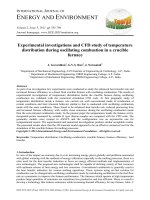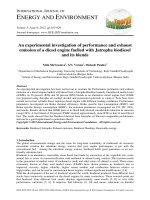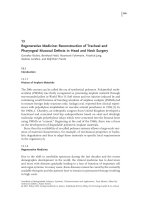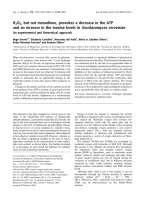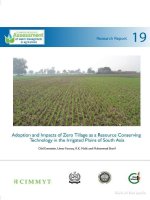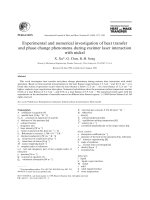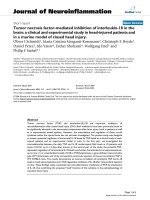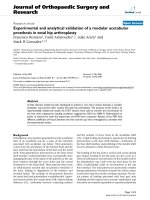Experimental and theoretical research of zero head innovative horizontal axis archimedean screw turbines
Bạn đang xem bản rút gọn của tài liệu. Xem và tải ngay bản đầy đủ của tài liệu tại đây (1.21 MB, 8 trang )
INTERNATIONAL JOURNAL OF
ENERGY AND ENVIRONMENT
Volume 6, Issue 5, 2015 pp.471-478
Journal homepage: www.IJEE.IEEFoundation.org
ISSN 2076-2895 (Print), ISSN 2076-2909 (Online) ©2015 International Energy & Environment Foundation. All rights reserved.
Experimental and theoretical research of zero head
innovative horizontal axis archimedean screw turbines
Alkistis Stergiopoulou
1,2
, Vassilios Stergiopoulos
3
, Efrossini Kalkani
1
1
National Technical University of Athens, Department of Water Resources and Environmental
Engineering, School of Civil Engineering, 15780 Athens, Greece.
2
University of Natural Resources and Life Sciences, Institute for Water Management, Hydrology and
Hydraulic Engineering,
Muthgasse 18, A-1190 Vienna, Austria.
3
School of Pedagogical and Technological Education, Department of Civil Engineering Educators,
ASPETE Campus, Eirini Station, N.Heraklio, 14121 Athens, Greece.
Abstract
The first aim of this paper is to present data concerning the design, construction, installation and
operation of the first in the world Horizontal Axis Archimedean Screw Turbine (H.A.A.S.T.), having a
length L=1m, diameters (output and input) D
o
=200mm and D
i
=100mm, a pitch S=200mm and a number
of blades n=3. This horizontal screw could rotated horizontally and change direction (∆θ = 100
o
),
forming an upstream angle of 50
o
with its initial position and a downstream angle of 50
o
with its initial
position. The second aim of the paper is to present experimental results of the operation in a big
hydraulic channel under various controlled conditions, simulating the operation of the physical
conditions of rivers, open channels, etc. The third aim of the paper is to present a series of theoretical
performance prediction results based on various S1/S2 algorithms and Linear Actuator Disk simulations.
Copyright © 2015 International Energy and Environment Foundation - All rights reserved.
Keywords: Archimedean turbines; Horizontal screw; Renewable energy systems; Kinetic energy.
1. Introduction
All hydropower turbines convert hydraulic energy into rotational mechanical energy, which is
subsequently converted in electric energy [1]. There are three types of turbines, the reaction, the impulse
and the Archimedean screw turbines, the difference being mainly the manner of water head conversion.
In the last centuries many turbines, which work on the basis of the three types, have been invented. This
doesn’t mean that there can’t be new inventions in this field [2-4]. The paper presents theoretical and
experimental research of an innovative Horizontal Axis Archimedean Screw Turbines (H.A.A.S.T.)
harnessing the kinetic energy of rivers, currents and open channels works, newly developed under the
present ARCHIMEDES III research.
The possibility of exploiting kinetic hydraulic energy of irrigation and drainage hydraulic networks, and
currents of technical and natural watercourses, represents a large renewable energy resource. Pleiades of
zero head sites in small and big watercourses, open water channels, as well as important sea and tidal
currents, could be used for recovering zero head hydraulic energy and marine power for electricity
generation. Little attention has been given towards this exploitation, despite the fact that such zero head
International Journal of Energy and Environment (IJEE), Volume 6, Issue 5, 2015, pp.471-478
ISSN 2076-2895 (Print), ISSN 2076-2909 (Online) ©2015 International Energy & Environment Foundation. All rights reserved.
472
sites and currents represent a large renewable energy resource that could be exploited by modern
horizontal axis Archimedean hydropower technologies to provide impressive levels of electric power.
2. Towards the first in the world horizontal axis Archimedean turbine
The first in the world Horizontal Archimedean Screw Turbine, recently proposed by A. Stergiopoulou [5,
6], is installed and experimented in the hydraulic channel of the Institute for Water Management,
Hydrology and Hydraulic Engineering/Department für Wasser-Atmosphäre-Umwelt/Institut für
Wasserwirtschaft, Hydrologie und konstruktiven Wasserbau (IWHW), in Vienna, with the main
geometrical characteristics L
channel
= 4.17m, b
channel
= 1.4m, h
channel
(depth)=1m. Four characteristic views
of experimental tests in this hydraulic channel before the installation of the Horizontal Axis
Archimedean Screw Turbine are given in Figure 1.
Figure 1. Four characteristic views of experimental tests in the hydraulic channel before the installation
of the Archimedean Screw (photos A. Stergiopoulou, [5])
The length L, the diameters (output and input), the pitch S, and the number of blades of the new screw
rotor are: L= 1m, D
o
= 200mm, D
i
= 100mm, S/Do = 1, S=200 mm, n= 3 (number of blades) (Figure 2).
Figure 2. Design of the horizontal screw rotor (A. Stergiopoulou, [5])
International Journal of Energy and Environment (IJEE), Volume 6, Issue 5, 2015, pp.471-478
ISSN 2076-2895 (Print), ISSN 2076-2909 (Online) ©2015 International Energy & Environment Foundation. All rights reserved.
473
This screw rotor could rotated horizontally and change direction (∆θ =100
o
), forming an upstream angle
of 50
o
with its initial position and a downstream angle of 50
o
with its initial position (Figure 3).
Figure 3. The horizontal screw rotor could change horizontally direction (∆θ = 100
o
)
(photos A. Stergiopoulou, [5])
Some information concerning two possibilities for the rotation of the horizontal screw is given in Figure
4 below. According to the 1
st
possibility the screw rotor stays horizontal and is based on a “guide” at his
right edge. The rotor could be moved along its “guide” towards “above” and “below” (inside the
hydraulic channel of a depth 1m). According to the second possibility the horizontal screw rotor could be
rotated horizontally (θ1, θ2, θ3….) with the help of the “right guide”, which could also be rotated.
Figure 4. Rotation possibilities of the horizontal screw (A. Stergiopoulou [5])
3. Experimental investigations of the first H.A.A.S.T.
To configure the horizontal Archimedean screw, from a design and experimental point of view, were
used the design software (CAD) which is able to perform a two-dimensional design and also a three-
dimensional parametric geometry. Furthermore, were used specific objects, namely the cylinder and
blades of the rotor. These objects were changed in order to have the desired dimensions, as described
follows. Initially, was constructed the cylinder with fixed length and diameter. Then the screw blade
constructed so that the internal radius coincides with the radius of the cylinder and its length is an integer
multiple of the cylinder length. Then all the parts of the helix were placed on the cylinder along its
length. Furthermore we use 2 and 3 helices, as shown below for the case of three blades. Then it is easy
the final form of the 3-bladed screw. Constructing of three blades and then placing the blades along the
cylinder. Figure 5 gives some perspective representations of the characteristic similarities between the
design and the real construction of the first in the world Horizontal Archimedean Screw Turbine.
International Journal of Energy and Environment (IJEE), Volume 6, Issue 5, 2015, pp.471-478
ISSN 2076-2895 (Print), ISSN 2076-2909 (Online) ©2015 International Energy & Environment Foundation. All rights reserved.
474
Figure 5. Perspective representations of the characteristic similarities between the design and the real
construction of the first in the world horizontal archimedean screw turbine (photos A. Stergiopoulou [5])
Some views of the initial steps of the 3-bladed horizontal axis Archimedean screw rotor are given in
Figure 6.
Figure 6. Views of the new 3-bladed horizontal axis Archimedean screw rotor
Figure 7 gives three rrepresentative views of the final H.A.A.S.T. steps before installing it in the
experimental channel of the Institute for Water Management, Hydrology and Hydraulic Engineering
(IWHW) of Vienna.
Figure 7. Steps towards the installation of the Archimedean Screw (photos A. Stergiopoulou [5])
Figure 8 gives seven characteristic views of the first in the world developed horizontal axis 3-bladed
Horizontal Axis Archimedean Turbine in experimental operation in the hydraulic channel of the Institute
for Water Management, Hydrology and Hydraulic Engineering/Department für Wasser-Atmosphäre-
Umwelt / Institut für Wasserwirtschaft, Hydrologie und konstruktiven Wasserbau (IWHW), in Vienna.
International Journal of Energy and Environment (IJEE), Volume 6, Issue 5, 2015, pp.471-478
ISSN 2076-2895 (Print), ISSN 2076-2909 (Online) ©2015 International Energy & Environment Foundation. All rights reserved.
475
Figure 8.
Seven characteristic views of the first in the world developed horizontal axis 3-bladed horizontal
axis archimedean turbine in experimental operation in the channel (photos A. Stergiopoulou [5])
The experimental results of the efficiency performances of the Horizontal Axis Archimeden Screw
Turbine, for different values of the flow discharge Q = 40 l/s - 120 l/s, for different values of the
orientation angle, θ = 0
ο
- 30
ο
, are presented in the 3D - diagram of Figure 9.
Figure 9. Efficiency experimental results of the Horizontal Axis Archimeden Screw Turbine operating in
the Channel (A. Stergiopoulou [5])
4. Preliminary theoretical investigation of the first H.A.A.S.T.
To illustrate a quite simple basic theory of horizontal screw machine based on the drag principle or in the
S1/S2 Black-Box flow theory [5], the undershot screw waterwheel could be considered as a first
example. Consider the screw waterwheel, having an effective radius R, a blade area A
b
and an angular
velocity ω rotating in a stream flow of velocity V=V
c
(see Figure 10).
International Journal of Energy and Environment (IJEE), Volume 6, Issue 5, 2015, pp.471-478
ISSN 2076-2895 (Print), ISSN 2076-2909 (Online) ©2015 International Energy & Environment Foundation. All rights reserved.
476
Figure 10. Approximations of the screw waterwheel rotating in stream flows (left) and the principle of
S1/S2 Black-Box flow theory (right)
The force exerted on the flat blade, simulating one screw blade, is given by the relation, F
d
= 0.5. ρ . Α
b
.
C
d
.V
r
2
, where ρ represent the fluid density, C
d
is the blade coefficient of drag and V
r
is the difference
(V
c
-V
b
) between stream flow velocity V
c
and blade velocity V
b
=ω.R. The relative velocity V
r
decreases
as ω/R approaches V
c
and the force F
d
decreases toward zero. The power produced by the blade can be
calculated with P
T
= F
d
. V
b
= 0.5 . ρ . Α
b
. C
d
. ω . R . (V
c
- V
b
)
= 0.5 . ρ . Α
b
. C
d
. ω . R . (1 - λ)
2
. V
c
3
,
where λ is the tip-speed ratio. By using Cp
= C
d
. λ . (1 - λ)
2
the power relation reduces to P
T
= 0.5 . ρ . Α
b
.
C
p
.
V
c
3
. The derived function for Cp gives a value of zero for λ = 0 and λ = 1 and a maximum value of
0.148 for λ =1/3. The power for constant-speed operation is proportional to (C
p
/λ
3
) but as the stream
velocity increases the power continues to increase. Τhe flow and the geometrical data are V
c
= 1.76 m/s
[6].
For these preliminary calculations, the following characteristic values are used: F
d
=51.62N, ω=7.882 r/s,
T= F
d
.R=3.8175N.m, V
b
=V
c
/3=0.5866 m/s. The power produced by the horizontal screw wheel is P
T
=
ω.Τ = 2.π.n.T, where ω is the angular velocity of the runner, T is the torque acting on the turbine shaft,
and N is the rotational speed of the runner. The hydraulic efficiency of the screw turbine is defined as the
ratio between the mechanical power developed by the turbine to the available theoretical water power,
η
hyd
= P
t
/P
th
. For the developed by A. Stergiopoulou new experimental 3-bladed horizontal Archimedean
screw rotor, the minimum blade wet area is Α
b
= L
b
. (R
o
-R
i
) =1 (m) x0 .05(m) = 0.05 m
2
, and the
maximum blade wet area Α
b
= L
b
. 2.R
o
=1x 0.20 = 0.20 m
2
, with L
b
= length of the blade, R
o
and R
i
are
the outlet and the inlet of the blade.
Then, the theoretical power of the input current of the Cephalonia Sea River, in the open channel, could
be P
th
=(1/2).ρ.Α
b
.C
d
.V
c
3
= 136,29 W [7-9]. In the Sami’s exit Cephalonia Sea River there is for the
developed machine P
th
=(1/2).ρ.Α
b
.C
d
.V
c
3
=0.5. 1025.0.20.1. 1.62
3
= 435.78 W. In the Argostoli’s input
there is for the same machine P
th
=(1/2).ρ.Α
b
.C
d
.V
c
3
= 0.5. 1025.0.20.1. 0.52
3
= 14.41 W.
If the machine could cover the whole wet section then the power performances will be 108.1 W in the
input and 2178.91 W at the exit section. However a series of Archimedes screws, as Archimedean Screw
Farms, in the Argostoli input and in the Sami’s exit, could give more interesting power performances. If
the wet section of one bigger horizontal screw turbine, having a blade height equal to the depth of the
input or output channel of Cephalonia, is the whole channel section, Α
b
= L
b
. 2.R
o
=2m x 0.5m =1m
2
, then
the theoretical kinetic potential for a current speed 1.62 m/s is around of 2178.91 W. A rough estimation
of the maximum installed power capacity for such a turbine should be 1.62 KW. A farm with a series of
1000 similar turbines will give a total installed capacity of 1.62 MW.
With the known tidal graphs of North and South Port of Chalkis, on the Euripus Strait, installed by the
Hydrographical Department of War Navy, the mean velocity Nord-South tidal current is 2.01 m/s and the
mean South-Nord tidal current is 2.29 m/s [7-9]. The maximum velocity developed, in the overall section
of the Strait is in average 2m/sec.
The mean current velocity, undependably from the direction is around of 1.27 m/s. In the area of the
Euripus the mean per m
2
kinetic power potential, undependably from the current direction, is about P/Α
=1.05 KW/m
2
. The power density of the North-South current is P/Α = 4.16 KW/m
2
. The South-North
power density is P/Α = 6.15KW/m
2
. For the whole cross section of the Euripus Straits the values of the
International Journal of Energy and Environment (IJEE), Volume 6, Issue 5, 2015, pp.471-478
ISSN 2076-2895 (Print), ISSN 2076-2909 (Online) ©2015 International Energy & Environment Foundation. All rights reserved.
477
theoretical kinetic power of the North-South and South-North currents are P
NS-th
=1331.8 KW and P
SN-th
=1969.5 KW. The theoretical kinetic power undependably from the current direction P
th
=335.9 KW.
Taking into account the limit of Lanchester-Betz (16/27=0.593) the corresponding Lanchester-Betz
kinetic power values are P
L-Betz(NS)
= 789.2 ΚW, P
L-Betz(SN)
=1167.1 KW and P
L-Betz
=335.9 KW. A rough
estimation of the Euripus Straits yearly kinetic energy potential gives Ε
Betz(NS)
= 3457 ΜWh and Ε
Betz(SN)
= 5112 ΜWh. For one Horizontal Axis Archimedean Screw Turbine (HAAST) having a diameter D
e
=
2,0 m and length B = 2 m, with a wet section A = B · (D
e
/2) = 2 · 1,0 = 2 m
2
, the maximum installed
power capacity will be P=3.647 W. For the same section a series of 20 similar HAAST devices will give
P
20
= 72.943 W. Thirty similar series will have one installed power capacity P
30,20
=2.188.290W=2.188,
3KW=2.19 MW. The two possibilities to install Parks of Horizontal Axis Archimedean Screw Turbines
in the southern harbor of Chalcis are presented in the Figure 11. A similar scenario could be considered
also for the northern harbor of Chalcis. It is obvious that the total installed power capacity for such
HAAST hydrokinetic farms in the areas of the Euripus Straits could be more than 4 MW. The
corresponding yearly energy produced could be around 32.000 MWh.
5. Conclusions for further research efforts
This paper has explored the performance characteristics of a very promising new small hydropower
system, an innovative horizontal Archimedean hydropower screw turbine. Pleiades of zero head sites, in
small and big watercourses, open water channels, as well as important sea and tidal currents, could be
harnessed by such and horizontal screws for recovering hydraulic energy.
A series of experimental studies continues in the Institute for Water Management, Hydrology and
Hydraulic Engineering/Department für Wasser-Atmosphäre-Umwelt / Institut für Wasserwirtschaft,
Hydrologie und konstruktiven Wasserbau (IWHW), in Vienna, with another new version of the first in
the world Horizontal Axis Archimedean Screw Turbine, having the torquemeter, in another new position,
outside of the water (Figure 11).
Figure 11. A panoramic view of the new version of the whole innovative Horizontal Axis Archimedean
Screw Turbine, in operation in the hydraulic channel of IWHW, in Vienna (photo A.Stergiopoulou [5])
The S1/S2 Black-Box flow theory will be used in order to predict the performances of the Horizontal
Axis Archimedean Turbine and to compare with all the collected and the new experimental results.
However, the diagrams obtained for the radial impulse turbine show that the highest efficiency of such a
turbine prototype could not be measured, so it is hard to analyses the turbine performance. It seems that
to determine the maximum efficiency and the turbine performance of this prototype further
measurements with more operation points are necessary. Due to optimisations, for example of the jet
nozzle, the rotor, the air gap and so on, the efficiency could be increased. Therefore more measurements
of different prototypes, mathematic calculations or simulation are needed.
International Journal of Energy and Environment (IJEE), Volume 6, Issue 5, 2015, pp.471-478
ISSN 2076-2895 (Print), ISSN 2076-2909 (Online) ©2015 International Energy & Environment Foundation. All rights reserved.
478
Acknowledgements
This research has been co-financed by the European Union (European Social Fund – ESF) and Greek
national funds through the Operational Program "Education and Lifelong Learning" of the National
Strategic Reference Framework (NSRF) - Research Funding Program ARCHIMEDES III (Investing in
knowledge society through the European Social Fund) as part of the research project “Rebirth of
Archimedes: Contribution to the study of hydraulic mechanics and hydrodynamic behaviour of
Archimedean cochlear waterwheels, for recovering the hydraulic potential of natural and technical
watercourses, of maritime and tidal currents”.
References
[1] European Small Hydropower Association, “A Layman's Guidebook on How to Develop a Small
Hydro Site”, ESHA., 1998.
[2] P.J. Kantert, “Praxishandbuch Schneckenpumpe“, Hirthammer Verlag 2008, ISBN 978-3-88721-
202-5, 2008.
[3] B. Pelikan, A. Lashofer, “Verbesserung der Strömungseigenschaften sowie Planungs-und
Betriebsoptimierung von Wasserkraftschnecken Research Project, BOKU University, Vienna, (in
German), 2012.
[4] A. Stergiopoulou, V. Stergiopoulos, “From the old Archimedean Screw Pumps to the new
Archimedean Screw Turbines for Hydropower Production in Greece”, Proceedings of SECOTOX
and CEMEPE Conference, Mykonos, 2009.
[5] A. Stergiopoulou, “Ph.D. in preparation in NTUA (Athens) and BOKU (Vienna)”, 2015.
[6] A. Stergiopoulou, B. Mayrhofer, Towards an Innovative Radial Flow Impulse Turbine and a New
Horizontal Archimedean Hydropower Screw, J. Energy Power Sources, Vol. 1, No. 2, 2014, pp. 71-77.
[7] V. Stergiopoulos, G. Stergiopoulos, A. Stergiopoulou, " The coastal Cephalonia’s paradox: Quo
vadis?", Proceedings of the 1st International Conference on Environmental Management,
Engineering, Planning and Economics - CEMEPE , Skiathos, 2007.
[8] V. Stergiopoulos, A. Stergiopoulou, “The Coastal Cross-Flow Cephalonia’s Paradox: A Lost
Atlantic Attractor”, Proceedings of the 2nd International Conference “The Atlantis Hypothesis:
Searching for a Lost Land”, Athens, 10-11 November 2008.
[9] V. Stergiopoulos, A. Stergiopoulou, “The paradox of coastal cross flow in Cephalonia island”,
Proceeding of the 6th International Symposium on Environmental Hydraulics, Athens, 2010.
Alkistis Stergiopoulou is Ph.D. Candidate of the National Technical University of Athens, Master o
f
Science in Water Resourses & Technology (Civil Engineering School, National Technical University o
f
Athens, 2008), Master in Total Quality Management (Open University of Greece, 2012), BSc in Natural
Resources Management & Engineering (Agricultural University of Athens, 2007). She is Researc
h
Associate in BOKU University of Natural Resources and Life Sciences (Vienna, Austria, 2014-2015)
and Basic Scientific Member of the National Research Project ARCHIMEDES III. Her main research
interests are, Archimedean Screw Turbines, Small Hydropower, Renewable Energy Sources, C.F.D.,
Applied Hydraulics and Fluid Mechanics.
E-mail adress:
Vassilios Stergiopoulos is Professor of Hydraulics and Hydropower at the Civil Engineering Educators
Department of the School of Pedagogical and Technological Education (ASPETE, Athens, Greece),
Docteur d’Etat ès Sciences Mathématiques (University of Aix-Marseille II, France) Docteur-Ingenieu
r
and D.E.A. in Fluid Mechanics (University of Aix-Marseille). His main research interest are
Archimedean Screw Turbines and Plants, Small Hydropower and Hydraulic Turbomachines,
Renewable Energy Sources, Environmental Hydraulics and Fluid Mechanics, C.F.D.
E-mail adress: ,
Efrossini Kalkani is Professor Emeritus of the N.T.U.A. (National Technical University of Athe
n
Professor of Hydropower and Hydropower at the Civil Engineering School of the N.T.U.A. Her m
a
research interests are, Renewable Energy Sources, Hydropower and Energy Production, Archimed
e
Screw Turbines, Applied Hydraulics, New and Green Technologies.
E-mail adress:
